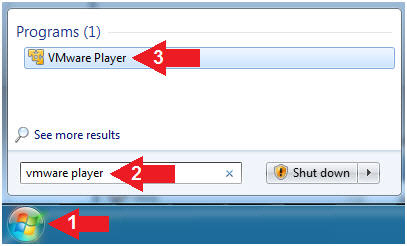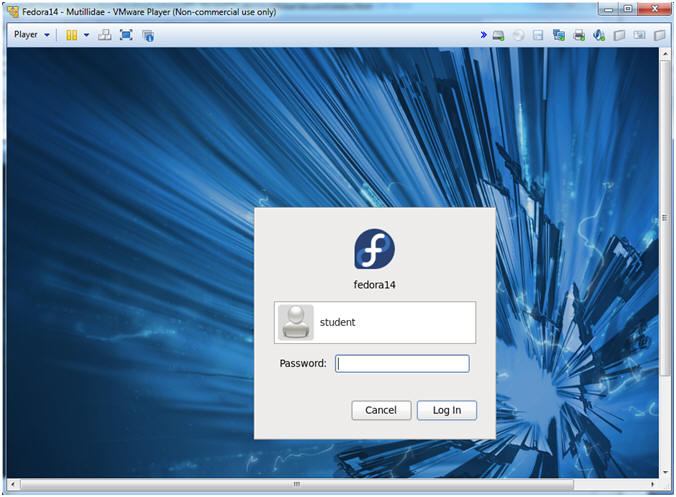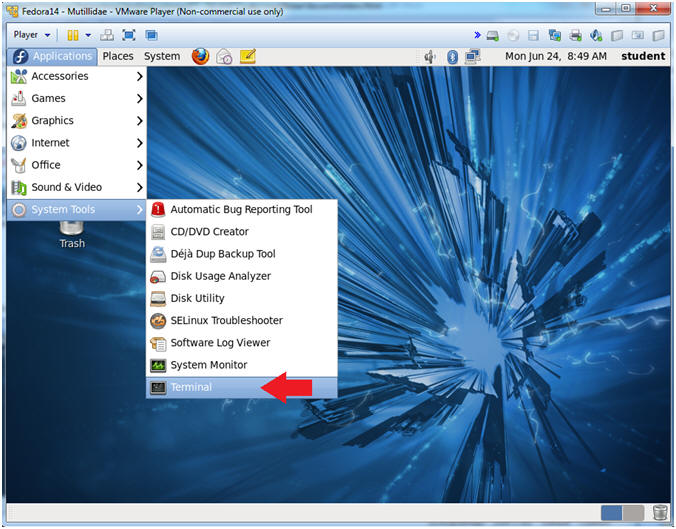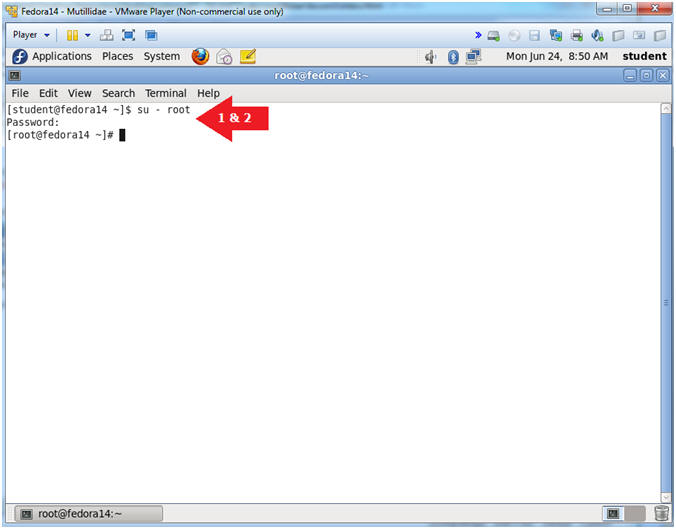(Mutillidae: Lesson 4)
{ Brute Force Using Burp Suite and crack_web_form.pl }
| Section 0. Background Information |
- What Mutillidae?
- OWASP Mutillidae II is a free, open source, deliberately vulnerable web-application providing a target for web-security enthusiast.
- What is Burp Suite?
- Burp Suite is a Java application that can be used to secure or crack web applications. The suite consists of different tools, such as a proxy server, a web spider, an intruder and a so-called repeater, with which requests can be automated.
- When Burp suite is used as a proxy server and a web browser uses this proxy server, it is possible to have control of all traffic that is exchanged between the web browser and web servers. Burp makes it possible to manipulate data before it is sent to the web server.
- What is Brute Force?
- A Brute Force attack is a type of password guessing attack and it consists of trying every possible code, combination, or password until you find the correct one. This type of attack may take long time to complete. A complex password can make the time for identifying the password by brute force long.
- Dictionary Attack:
- A dictionary attack is another type of password guessing attack which uses a dictionary of common words to identify the user's password.
- What is crack_web_form.pl
- crack_web_form.pl is a very basic perl script/tool written by computersecuritystudent.com that uses a combination of (1) http-post-data, (2)a password list, and (3) error messages to test passwords for specific usernames.
- Pre-Requisite Lab
-
Mutillidae: Lesson 1: How to Install Mutillidae in Fedora 14
- Note: Remote database access has been turned on to provide an additional vulnerability.
-
BackTrack: Lesson 1: Installing BackTrack 5 R1
- Note: This is not absolutely necessary, but if you are a computer security student or professional, you should have a BackTrack VM.
-
Mutillidae: Lesson 1: How to Install Mutillidae in Fedora 14
-
Lab
Notes
- In this lab we will do the following:
- Test the Login.php script for wrong passwords and display an error message.
- Configure Firefox Proxy to use Burp Suite.
- Capture HTTP-POST-DATA with Burp Suite
- Download and Run crack_web_form.pl (Version 2.0).
- Test the Login.php script with cracked password.
- In this lab we will do the following:
- Legal Disclaimer
- As a condition of your use of this Web site, you warrant to computersecuritystudent.com that you will not use this Web site for any purpose that is unlawful or that is prohibited by these terms, conditions, and notices.
- In accordance with UCC § 2-316, this product is provided with "no warranties, either express or implied." The information contained is provided "as-is", with "no guarantee of merchantability."
- In addition, this is a teaching website that does not condone malicious behavior of any kind.
- Your are on notice, that continuing and/or using this lab outside your "own" test environment is considered malicious and is against the law.
- © 2013 No content replication of any kind is allowed without express written permission.
| Section 1: Configure Fedora14 Virtual Machine Settings |
- Start VMware Player
- Instructions
- For Windows 7
- Click Start Button
- Search for "vmware player"
- Click VMware Player
- For Windows XP
- Starts --> Programs --> VMware Player
- For Windows 7

- Instructions
- Edit Fedora Mutillidae Virtual Machine Settings
- Instructions:
- Highlight Fedora14 - Mutillidae
- Click Edit virtual machine settings

- Instructions:
- Edit Network Adapter
- Instructions:
- Highlight Network Adapter
- Select Bridged
- Click the OK Button

| Section 2: Login to Fedora14 - Mutillidae |
- Start Fedora14 VM Instance
- Instructions:
- Start Up VMWare Player
- Select Fedora14 - Mutillidae
- Play virtual machine

- Instructions:
- Login to Fedora14 - Mutillidae
- Instructions:
- Login: student
- Password: <whatever you set it to>.
-

- Instructions:
| Section 3: Open Console Terminal and Retrieve IP Address |
- Start a Terminal Console
- Instructions:
- Applications --> Terminal

- Instructions:
- Switch user to root
- Instructions:
- su - root
- <Whatever you set the root password to>
-

- Instructions:
- Get IP Address
- Instructions:
- ifconfig -a
- Notes (FYI):
- As indicated below, my IP address is 192.168.1.111.
- Please record your IP address.
- Instructions:
| Section 4: Configure BackTrack Virtual Machine Settings |
- Start VMware Player
- Instructions
- For Windows 7
- Click Start Button
- Search for "vmware player"
- Click VMware Player
- For Windows XP
- Starts --> Programs --> VMware Player
- For Windows 7

- Instructions
- Edit the BackTrack5R1 VM
- Instructions:
- Select BackTrack5R1 VM
- Click Edit virtual machine settings

- Instructions:
- Edit Virtual Machine Settings
- Instructions:
- Click on Network Adapter
- Click on the Bridged Radio button
- Click on the OK Button
- Instructions:
| Section 5: Play and Login to BackTrack |
- Play the BackTrack5R1 VM
- Instructions:
- Click on the BackTrack5R1 VM
- Click on Play virtual machine

- Instructions:
- Login to BackTrack
- Instructions:
- Login: root
- Password: toor or <whatever you changed it to>.

- Instructions:
- Bring up the GNOME
- Instructions:
- Type startx

- Instructions:
| Section 6: Open Console Terminal and Retrieve IP Address |
- On BackTrack, Start up a terminal window
- Instructions:
- Click on the Terminal Window
- Instructions:
- Obtain the IP Address
- Instructions:
- ifconfig -a
- Note(FYI):
- My IP address 192.168.1.109.
- In your case, it will probably be different.
- This is the machine that will be use to attack the victim machine (Metasploitable).

- Instructions:
| Section 7: Start Web Browser Session to Mutillidae |
- On BackTrack, Open Firefox
- Instructions:
- Click on the Firefox Icon
- Notes (FYI):
- If FireFox Icon does not exist in the Menu Bar Tray, then go to Applications --> Internet --> Firefox Web Browser

- Instructions:
- Open Mutillidae
- Notes (FYI):
- Replace 192.168.1.111 in the following URL --> http://192.168.1.111/mutillidae, with your Mutillidae's IP Address obtained from (Section 3, Step 3)
- Instructions:
- http://192.168.1.111/mutillidae

- Notes (FYI):
| Section 8: Blog Reconnaissance |
- Select View Someones Blog
- Instructions:
- OWASP Top 10 --> A1 - SQL Injection --> SQLMAP Practice --> View Someones Blog

- Instructions:
- Possible Usernames
- Instructions:
- Click on Please Choose Author
- Note(FYI):
- Without even logging in, you are able to view logs of other users.
- This is normally not a big deal.
- However, the below list box will contain the value or the database username of each displayed username.

- Instructions:
- View Source Code for View Someones Blog
- Instructions:
- Right Click on white background
- Click on View Page Source

- Instructions:
- Search Source Code for Username
- Instructions:
- Press the <Ctrl> and <f> keys to search the source code
- Type
"admin"
and press enter
- Include the quotes
- Note(FYI):
- Notice for every username in this line, there will be a tag called <option value="USERNAME">.
- <option value="admin">admin</option>
- <option value="admin" - This is the database value
- >admin</option> - This is the display name of the user

- Instructions:
- Parse Source Code for Username
- Note(FYI):
- Replace 192.168.1.111 with the Fedora(Mutillidae) IP Address obtained from (Section 3, Step 3).
- Below is just a small tutorial on using a little bit of elbow grease (curl, grep, sed and awk) to do a lot of parsing.
- Instructions:
- curl -L "http://192.168.1.111/mutillidae/index.php?page=view-someones-blog.php"
2>/dev/null | grep -i \"admin\" | sed 's/"//g' | awk 'BEGIN{FS=">"}{for
(i=1; i<=NF; i++) print $i}' | grep -v value | sed s'/<\/option//g'
- curl -L "Webpage", retrieves the source code of a webpage.
- 2>/dev/null, means do not view errors or curl status output.
- grep -i \"admin\", display curl output that contains the string "\"admin\"".
- sed 's/"//g', use sed to replace quotes with nothing
- awk 'BEGIN{FS=">"}{for (i=1; i<=NF; i++) print $i}', use the ">" character as a delimiter or field separator and print each array element on a separate line
- grep -v value, display array element output that only contains the string "value".
- sed s'/<\/option//g', use sed to replace the string "</option" with nothing.
- curl -L "http://192.168.1.111/mutillidae/index.php?page=view-someones-blog.php"
2>/dev/null | grep -i \"admin\" | sed 's/"//g' | awk 'BEGIN{FS=">"}{for
(i=1; i<=NF; i++) print $i}' | grep -v value | sed s'/<\/option//g'

- Note(FYI):
| Section 9: Viewing Login.php Error Message |
- Test Login.php
- Instructions:
- Click Login/Register
- Name: admin
- Password: admin
- Click the Login Button

- Instructions:
- Copy the Login.php Error Message
- Instructions:
- Highlight "Authentication Error", and Right Click
- Select Copy

- Instructions:
- Open gedit
- Instructions:
- gedit &
- Press Enter

- Instructions:
- Paste Message
- Instructions:
- Press the <Ctrl> and <v> keys to paste message

- Instructions:
| Section 10: Viewing Login.php Source Code |
- View Login.php Source
- Instructions:
- Click on Login/Register
- Right Click on the white screen background, select View Page Source.

- Instructions:
- Analyze Login.php Source
- Instructions:
- Press the <Ctrl> and <f> keys at the same time
- Type form action in the find box and press enter.
- Notes (FYI):
- Notice the naming convention of the username and password textboxes.
- Notice the naming convention and value of the submit button.

- Instructions:
| Section 11: Configure Firefox Proxy Settings |
- View Preferences
- Instructions:
- Click on Firefox
- Select Preferences --> Preferences

- Instructions:
- Advanced Settings...
- Instructions:
- Click on the Advanced Icon
- Click on the Network Tab
- Click on the Setting... button

- Instructions:
- Connection Settings
- Instructions:
- Click on Manual proxy configurations
- Type "127.0.0.1" in the HTTP Proxy Text Box
- Type "8080" in the Port Text Box
- Check Use the proxy server for all protocols
- Click OK
- Click Close

- Instructions:
| Section 12: Configure Burp Suite |
- Start Burp Suite
- Instructions:
- Applications --> BackTrack --> Vulnerability Assessment --> Web Application Assessment ---> Web Vulnerability Scanner --> burpsuite
- Instructions:
- JRE Message
- Instructions:
- Click OK

- Instructions:
- Configure proxy
- Instructions:
- Click on the proxy tab
- Click on the options tab
- Verify the port is set to 8080

- Instructions:
- Turn on intercept
- Instructions:
- Click on the proxy tab
- Click on the intercept tab
- Verify the intercept button shows "intercept is on"

- Instructions:
- Try Logging in
- Note(FYI):
- You should already be on the Login Page.
- Replace 192.168.1.111 with the Fedora(Mutillidae) IP Address obtained from (Section 3, Step 3).
- Instructions:
- The following
URI should already be in the address box
- http://192.168.1.111/mutillidae/index.php?page=login.php.
- Name: admin
- Password: admin
- Click the Login
Button
- Note: The Webpage will not refresh, because it is waiting on Burp Suite.
- Continue to Next Step
- The following
URI should already be in the address box

- Note(FYI):
- Verifying Burp Suite Results
- Instructions:
- Highlight username=admin&password=admin&login-php-submit-button=Login and right click
- Click Copy
- Note(FYI):
- On the first line, you can see POST has occurred for login.php
- username=admin, username is the name of the textbox and admin is its' value.
- password=admin, password is the name of the textbox and admin is its' value.
- login-php-submit-button=Login, login-php-submit-button is the name of the button and Login is its' value.

- Instructions:
- Paste Message
- Instructions:
- Press the <Ctrl> and <v> keys to paste message
- Note(FYI):
- After this step, you should see
following two messages:
- Authentication Error
- username=admin&password=admin&login-php-submit-button=Login
- After this step, you should see
following two messages:

- Instructions:
| Section 13: Crack Web Form |
- Download and Prepare Crack Web Form
- Instructions:
- mkdir -p /pentest/passwords/cwf
- cd /pentest/passwords/cwf
- wget http://www.computersecuritystudent.com/SECURITY_TOOLS/MUTILLIDAE/MUTILLIDAE_2511/lesson4/cwf.v2.tar.gz
- ls -l cwf.v2.tar.gz
- tar zxovf cwf.v2.tar.gz

- Instructions:
- Crack Web Form Functionality
- Instructions:
- ./crack_web_form.pl -help | more

- Instructions:
- Using Crack Web Form
- Note(FYI):
- Replace 192.168.1.111 with the IP Address obtained (Section 3, Step 3).
- Instructions:
- ./crack_web_form.pl -U admin -http
"http://192.168.1.111/mutillidae/index.php?page=login.php"
-data
"username=USERNAME&password=PASSWORD&login-php-submit-button=Login"
-F "Authentication Error"
- -U, Is an optional parameter. It allows you to specify a username. If the username is not supplied, then the username will default to admin.
- -P, Is an optional parameter. It allows you to specify the location of the password file. The default password file is set to the password.txt file located in the same directory as crack_web_form.pl.
- -http,
Is a required parameter. It allows to specify the login page.
Supply the login page you used in (Section 12, Step 5).
- http://192.168.1.111/mutillidae/index.php?page=login.php
- -data,
Is a required parameter. It allows you to specify the HTTP POST
DATA.
- username=USERNAME, where USERNAME is either the default "admin" or replaced by the user supplied parameter.
- password=PASSWORD, where PASSWORD is replaced by values in the password file.
- "username=USERNAME&password=PASSWORD&login-php-submit-button=Login", this is the string we obtain from Burp Suite in (Section 12, Step 7).
- -F,
Is an optional parameter. It allows you to specify the
authentication failure message. Supply the failure message you
obtained in (Section 9, Step 11). The default failure message
is set to "fail|invalid|error", where the message is case
insensitive
- "Authentication Error", this is the string we obtain from (Section 9, Step 4).
- ./crack_web_form.pl -U admin -http
"http://192.168.1.111/mutillidae/index.php?page=login.php"
-data
"username=USERNAME&password=PASSWORD&login-php-submit-button=Login"
-F "Authentication Error"
- Note(FYI):
- Crack Web Form Results
- Instructions:
- crack_web_form.pl found the password (adminpass) for username (admin).

- Instructions:
| Section 14: Remove Firefox Manual Proxy Configuration |
- View Preferences
- Instructions:
- Click on Firefox
- Select Preferences --> Preferences

- Instructions:
- Advanced Settings...
- Instructions:
- Click on the Advanced Icon
- Click on the Network Tab
- Click on the Setting... button

- Instructions:
- Connection Settings
- Instructions:
- Click on the No proxy Radio Button
- Click on the OK Button
- Click on the Close Button

- Instructions:
| Section 15: Test Admin Password |
- Test Login.php
- Instructions:
- Click Login/Register
- Name: admin
- Password: adminpass
- The password was obtained from (Section 13, Step 4).
- Click the Login Button

- Instructions:
- Verify Login Message
- Note(FYI):
- Notice that message "Logged In Admin: admin (root)".

- Note(FYI):
| Section 16: Proof of Lab |
- Proof of Lab
- Instructions:
- cd /pentest/passwords/cwf
- cat crack_cookies.txt
- date
- echo "Your Name"
- Replace the string "Your Name" with your actual name.
- e.g., echo "John Gray"
-
Proof of Lab Instructions
- Press both the <Ctrl> and <Alt> keys at the same time.
- Do a <PrtScn>
- Paste into a word document
- Upload to Moodle
-

- Instructions:




